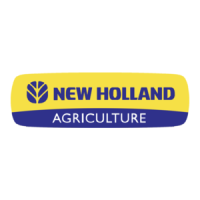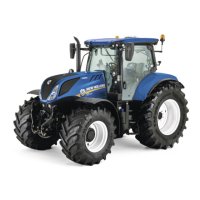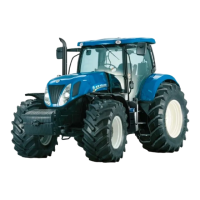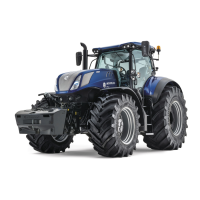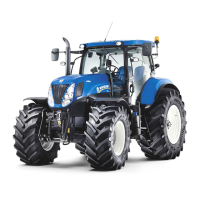Do you have a question about the New Holland T7030 and is the answer not in the manual?
Chart listing intervals for routine checks, lubrication, and service.
Procedures for storing the tractor for extended periods.
Fault finding for engine-related problems, causes, and corrections.
Fault finding for transmission-related problems, causes, and corrections.
Fault finding for hydraulic system problems, causes, and corrections.
General precautions to help prevent accidents before operating or servicing.
Safety precautions and advice for driving the tractor on roads and varied terrain.
Safety precautions and procedures for servicing the tractor, including cooling and hydraulic systems.
Safety precautions and recommendations for handling and using diesel fuel.
Information about the protective structure (ROPS/FOPS) and its importance.
Information on safety decals, their locations, and significance.
Importance of studying safety precautions and familiarizing with controls before operation.
General view of tractor controls located in the cab and on the platform.
Explanation of parking brake, clutch/inching pedal, and foot throttle controls.
Description of the instrument panel with analogue gauges, LCDs, and dot matrix display.
Information on coloured lights providing operating status and warning of malfunctions.
Description of the electronically controlled full powershift transmission and its functions.
Operation of differential locks in manual and automatic modes, including warnings.
Operation of the four-wheel drive system in manual and automatic modes.
Key information for operating the tractor in the field, including running-in.
Procedure for running-in the new tractor to ensure long and dependable service.
Step-by-step procedure for starting the engine, including safety checks and turbocharger cool-down.
Procedure for stopping the engine, including turbocharger cool-down.
Automatic system to boost engine power levels for increased loads.
Quick guide to recording, storing, and playing back sequences of actions for headland turns.
Operation of the optional Fast Steer system for quick steering response.
Description of rear PTO engagement, disengagement, and available system types.
Information on tractors equipped with front PTO and 3-point hitch.
System for sensing and controlling draft loading and implement height.
Description of the 3-point hitch for connecting and operating implements.
Attaching and detaching trailed equipment, including safety precautions and drawbar types.
Importance of proper ballasting and tyre selection for maximum tractor performance.
Engine oil viscosity selection based on temperature and sulphur content in fuel.
Chart detailing maintenance requirements and intervals for various operations.
Procedure for checking and topping up the engine coolant level.
Procedure for checking the engine oil level and adding oil if necessary.
Cleaning radiator and cooler cores to remove blockages.
Procedure for changing main and charge hydraulic/transmission oil filters.
Normal engine oil and filter change period, and factors affecting it.
Checking and adjusting valve tappet clearance with the engine cold.
Checking electrolyte level and procedures for battery removal.
Recommended service for the air conditioner system, including receiver/drier replacement.
Procedure for purging air from the fuel system to allow engine start.
Calibrating clutch packs in the Power Command transmission to compensate for wear.
Checking and adjusting brake pedal linkage for proper latch engagement.
Procedures and safety precautions for checking and adjusting tyre pressures.
Information on radial tyre markings, load index, speed symbols, and permissible loads.
How malfunction symbols and error codes identify faults in electronic systems.
Information on identifying problems, causes, and corrective actions for various tractor systems.
Common engine problems, possible causes, and corrections.
Common transmission problems, possible causes, and corrections.
Common hydraulic problems, possible causes, and corrections.
Problems related to 3-point hitch movement, controls, and status lights.
Common brake problems, possible causes, and corrections.
Problems related to dust ingress, air flow, and air conditioning not producing cool air.
Problems related to electrical system inoperability, slow starting, and charging failures.
Function and operation of the optional Intelliview II monitor for tractor information.
Operation and connection of the coolant immersion heater for easier cold starts.
Operation and connection of the transmission oil heater for faster warm-up in cold climates.
Operation of the rotating beacon switch and socket outlet.
Procedures for disconnecting battery power using the isolator switch.
Adjustment of dynamic front fenders to suit tyre sizes and track widths.
Dimensions of the tractor based on standard tyre sizes and models.
Capacities for fuel tank, cooling system, engine, transmission, PTO, hubs, and differential.
Detailed engine specifications including power, cylinders, bore, stroke, and speeds.
Transmission type, available options, and creeper gear details.
Rear PTO types, engine speeds for PTO speeds, and maximum PTO power.
Hydraulic system type, maximum pressure, and flow rates.
Service brake type, number of discs, front brake type, and parking brake details.
Steering type, turns from lock to lock, maximum angle of turn, and front wheel toe-in.
Specifications for alternator, battery, starting motor, and cold starting aid.
Minimum hardware tightening torques in inch-pounds and Newton meters for SAE grades.
List of inoperative checks to be performed during the first 50 hours.
List of operative checks to be performed with the tractor at normal operating temperature.
Checks related to engine, transmission, steering, and brake performance.
Checks related to cab mounting bolts, neutral start switches, and seat belts.
| Transmission | 18-speed Full PowerShift |
|---|---|
| Wheelbase | 113.4 inches |
| Weight | 14, 880 lbs |
| Engine Type | Diesel |
| Hydraulic Remotes | 4 |
| PTO Speed | 540/1000 rpm |
| Fuel Tank Capacity | 106.5 gallons |
| Transmission Type | Full Powershift / CVT |

